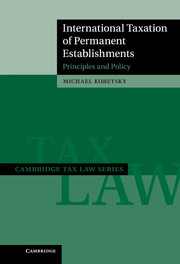Book contents
- Frontmatter
- Contents
- Abbreviations
- 1 Introduction
- 2 International taxation: policy and law
- 3 Some shortcomings of the tax treaty system
- 4 History of tax treaties and the permanent establishment concept
- 5 The role of the OECD Model Tax Treaty and Commentary
- 6 Defining the personality of permanent establishments under former Article 7 and the pre-2008 Commentary and the 2008 Commentary
- 7 Intra-bank loans under the pre-2008 Commentary and 1984 Report
- 8 Intra-bank interest under the 2008 Report
- 9 Business restructuring involving permanent establishments and the OECD transfer pricing methods
- 10 New Article 7 of the OECD Model and Commentary
- 11 Unitary taxation
- 12 Conclusion
- Bibliography
- Index
9 - Business restructuring involving permanent establishments and the OECD transfer pricing methods
Published online by Cambridge University Press: 07 September 2011
- Frontmatter
- Contents
- Abbreviations
- 1 Introduction
- 2 International taxation: policy and law
- 3 Some shortcomings of the tax treaty system
- 4 History of tax treaties and the permanent establishment concept
- 5 The role of the OECD Model Tax Treaty and Commentary
- 6 Defining the personality of permanent establishments under former Article 7 and the pre-2008 Commentary and the 2008 Commentary
- 7 Intra-bank loans under the pre-2008 Commentary and 1984 Report
- 8 Intra-bank interest under the 2008 Report
- 9 Business restructuring involving permanent establishments and the OECD transfer pricing methods
- 10 New Article 7 of the OECD Model and Commentary
- 11 Unitary taxation
- 12 Conclusion
- Bibliography
- Index
Summary
Introduction
The key features of international enterprises and multinational enterprise groups are that they carry on business operations in several countries and they conduct cross-border transactions; their size and centralized control provide them with efficiencies and cost savings from their intra-entity or intra-group transactions respectively, which are unavailable to independent enterprises carrying on similar business operations. Their reason for engaging in business restructuring is usually to either maintain or improve their competitive position; these enterprises engage in business restructuring to maximize synergies and economies of scale, to streamline the management of business lines and to improve the efficiency of global operations. Business restructuring is defined by the OECD as the cross-border transfer by an enterprise of functions, assets and risks.
A permanent establishment is treated as a separate and independent enterprise under the authorized OECD approach for attributing profits to the permanent establishment under the 2008 Commentary on former Article 7(2) and new Article 7(2). Permanent establishments may be involved in the business restructuring of an international enterprise if assets, functions and risks are transferred to, or from, a permanent establishment. The authorized OECD approach requires such transfers to be recognized for the purposes of Article 7. Business restructuring of international enterprises operating abroad through permanent establishments inevitably leads to changes in the allocation of business profits to the permanent establishments involved in the restructuring. Under former Article 7 the change in the allocation of profits must be consistent with the arm's length principle, but applying the arm's length principle to permanent establishments raises complex issues. Under the authorized OECD approach in the 2008 Report, a two-step process is used to attribute profits to a permanent establishment. The first step involves a functional analysis which in the case of business restructuring involving a permanent establishment requires examining whether assets, functions and risks have been transferred to, or from, a permanent establishment. Such transfers will qualify as notional intra-entity transactions. Under the second step, a transfer price must be determined for the transaction using the transfer pricing methods.
- Type
- Chapter
- Information
- International Taxation of Permanent EstablishmentsPrinciples and Policy, pp. 316 - 350Publisher: Cambridge University PressPrint publication year: 2011



